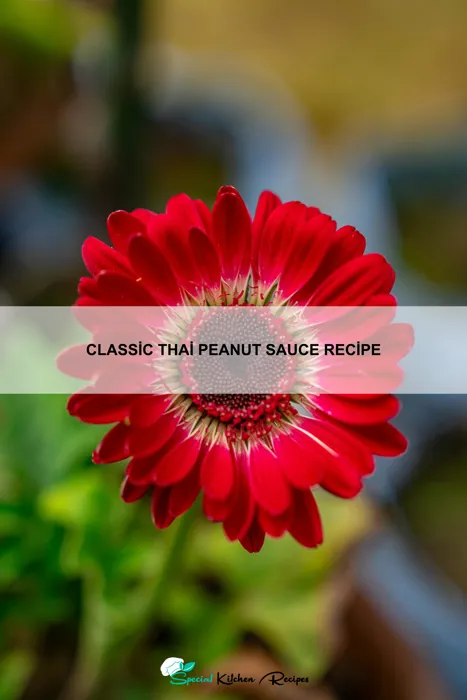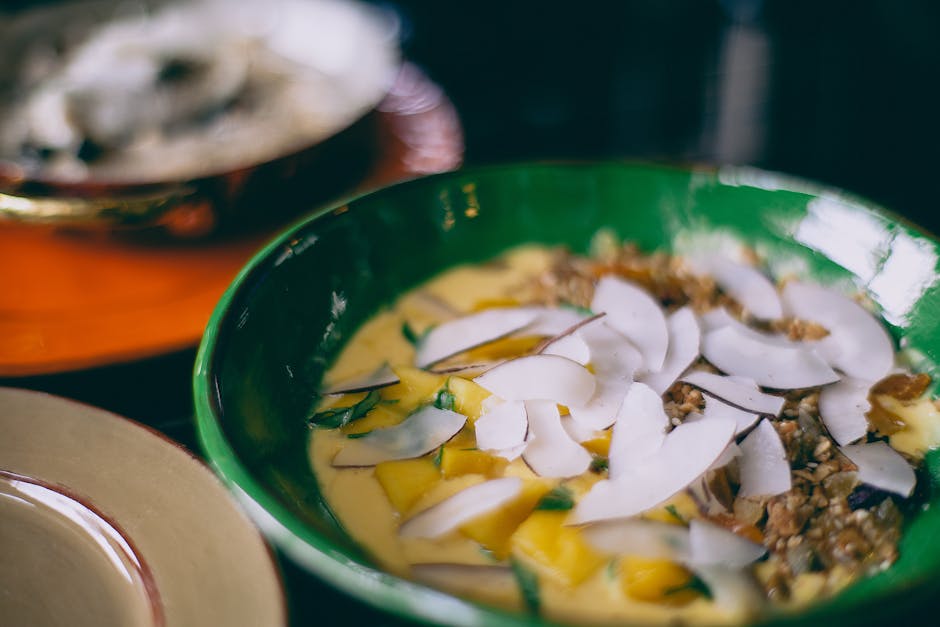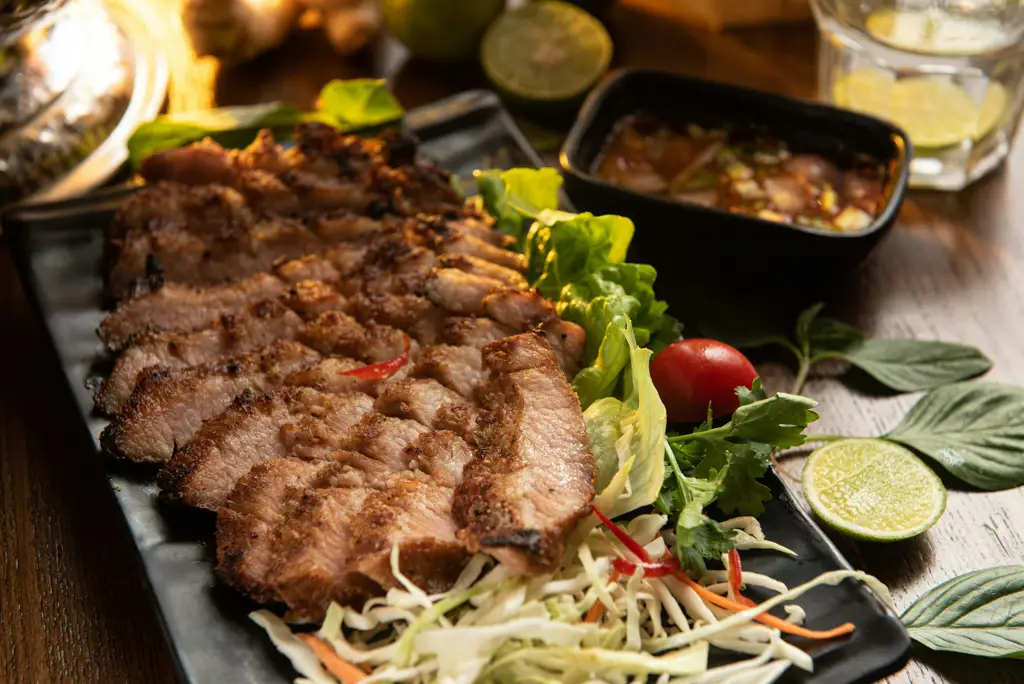Prepare to embark on a culinary journey to Thailand with this classic peanut sauce recipe! Peanut sauce, or nam prik kapi (น้ำพริกเผา) in Thai, is far more than just a condiment; it’s a cornerstone of Thai cuisine, reflecting the country’s rich history and diverse culinary influences. Its origins are deeply rooted in the agricultural heartland of Thailand, where peanuts, readily available and a staple crop, became a key ingredient in countless dishes. While the exact date of its creation remains obscured by time, its widespread use throughout Thai history points to a long and cherished tradition.
The sauce’s evolution is intertwined with Thailand’s trade relations. The introduction of peanuts to Southeast Asia, likely via trade routes with Africa and India centuries ago, significantly impacted the development of Thai cuisine. This wasn’t a simple addition; it marked a shift towards richer, more nuanced flavors. Peanut sauce’s popularity exploded, quickly becoming a staple in street food, formal restaurants, and home kitchens alike. Today, it’s estimated that over 80% of Thai households regularly incorporate peanut sauce into their meals, showcasing its enduring appeal.
Beyond its delectable taste, peanut sauce holds significant cultural weight in Thailand. It’s often served alongside quintessential Thai dishes like satay, noodles, spring rolls, and vegetables, acting as a harmonious bridge between diverse flavors and textures. The creamy, savory, and subtly sweet profile of the sauce is a reflection of the Thai philosophy of balance – a careful interplay of sweet, sour, salty, spicy, and bitter. Furthermore, the preparation and sharing of this sauce often become social events, strengthening bonds within families and communities. The versatility of this sauce also makes it a global favorite; adapted and enjoyed across the world, it stands as a testament to Thai culinary ingenuity.
Ingredients and Measurements
This recipe yields approximately 1 ½ cups of delicious Thai peanut sauce, perfect for noodles, spring rolls, satay, or as a dipping sauce. Accuracy in measurements is key to achieving the perfect balance of flavors, so please use a kitchen scale for the most precise results, especially for the peanut butter.
Peanut Butter: 1 cup (240g) smooth peanut butter. Using smooth peanut butter is crucial for a creamy, emulsified sauce. While crunchy peanut butter adds texture, it will result in a less smooth and potentially grainy final product. If you prefer a slightly chunkier sauce, you can pulse a small amount of crunchy peanut butter (about 1-2 tablespoons) into the finished sauce, but start with smooth.
Soy Sauce: 2 tablespoons (30ml) soy sauce or tamari for a gluten-free option. Soy sauce adds saltiness and umami, enhancing the overall flavor profile. Tamari offers a slightly sweeter and richer taste.
Lime Juice: 3 tablespoons (45ml) freshly squeezed lime juice. Freshly squeezed lime juice is non-negotiable for the best flavor and brightness. Bottled lime juice often lacks the essential oils that contribute to the vibrant taste of the sauce.
Rice Vinegar: 2 tablespoons (30ml) rice vinegar. This adds a subtle acidity that balances the richness of the peanut butter. White rice vinegar is preferred for its neutral flavor, allowing the other ingredients to shine.
Honey or Maple Syrup: 2 tablespoons (30g) honey or maple syrup. Choose your preferred sweetener based on your dietary needs and preferences. Honey will give a slightly more complex flavor, while maple syrup offers a distinct sweetness. Adjust the amount to your liking, depending on the sweetness of your peanut butter and other ingredients.
Water: 2-4 tablespoons (30-60ml) water. Start with 2 tablespoons and add more as needed to achieve your desired consistency. Adding water gradually is essential to prevent the sauce from becoming too thin or too thick.
Garlic: 1 clove garlic, minced or finely grated. Fresh garlic is recommended for the best flavor impact. Adjust the amount to your preference; some prefer a more pronounced garlic flavor.
Ginger: ½ teaspoon (1g) grated fresh ginger. Fresh ginger adds a subtle warmth and complexity to the sauce. You can adjust the amount depending on your preference for ginger. Ground ginger can be substituted, but the flavor will be slightly different.
Chili Garlic Sauce (optional): ½ – 1 tablespoon (7.5ml – 15ml), or to taste. This adds a spicy kick to the sauce. Start with a small amount and add more gradually, as chili garlic sauce can vary significantly in spiciness.
Sesame Oil (optional): ½ teaspoon (2.5ml) toasted sesame oil. This adds a nutty aroma and flavor. This is optional but highly recommended for a more authentic Thai peanut sauce flavor.
Equipment and Utensils
Making a truly authentic and delicious Classic Thai Peanut Sauce requires the right tools. While you might be able to adapt with what you have, investing in a few key pieces of equipment will significantly elevate your sauce-making experience and ensure consistent results.
A high-quality food processor is essential. A powerful food processor, capable of handling both wet and dry ingredients, is crucial for achieving the smooth, creamy texture characteristic of a good Thai peanut sauce. A less powerful blender might struggle with the thicker peanut butter and other ingredients. Aim for a food processor with at least a 10-cup capacity to handle the volume of ingredients specified in this recipe.
Measuring cups and spoons are vital for accuracy. Precise measurements are key to achieving the perfect balance of flavors in your peanut sauce. Use a set of standard measuring cups (dry and liquid) and spoons to ensure consistency in your culinary creations. Avoid relying on estimations, as even small variations in ingredient quantities can significantly impact the final taste and consistency.
A medium-sized saucepan is necessary for the sauce preparation. A non-stick saucepan (approximately 2-quart capacity) is recommended for gently heating the sauce ingredients. This prevents sticking and burning, especially when working with the peanut butter. Avoid using high heat; low to medium heat is sufficient to gently simmer and combine the ingredients.
A whisk is useful for preliminary mixing. Before transferring everything to the food processor, a whisk can be used to initially combine the ingredients in the saucepan. This helps prevent any clumping and ensures a smoother blending process later. A sturdy whisk, rather than a flimsy one, is recommended for efficient mixing.
Other helpful utensils include: a sturdy spatula for scraping down the sides of the food processor and the saucepan, a small bowl for measuring out smaller quantities of ingredients, and a fine-mesh sieve for straining the sauce (optional, for an exceptionally smooth texture).
Cleaning up is easier with the right tools: Keep a bowl of warm, soapy water handy for rinsing utensils as you go. Soaking the food processor bowl immediately after use will make cleaning significantly easier.
By gathering these tools before you begin, you will ensure a smooth and efficient process, allowing you to focus on creating the perfect Classic Thai Peanut Sauce.
Preparation Phase: (Includes ingredient prep like chopping peanuts, garlic, etc.)
Before you begin assembling the vibrant flavors of your Thai Peanut Sauce, meticulous preparation is key to achieving a perfectly balanced and smooth final product. This phase focuses on prepping all your ingredients to ensure even cooking and optimal flavor release.
Let’s start with the peanuts. We’ll be using 1 cup of roasted, unsalted peanuts. Avoid using salted peanuts as this will drastically alter the final saltiness of the sauce. For the best texture, I recommend using raw peanuts and dry-roasting them in a pan over medium heat for about 5-7 minutes, stirring frequently, until fragrant and lightly browned. Once cooled, roughly chop them. Aim for a mix of coarse and fine pieces for a pleasant textural contrast in the finished sauce. If using pre-roasted peanuts, simply chop them to your desired consistency.
Next, prepare the aromatics. We’ll need 4 cloves of garlic and 1 inch piece of ginger. Peel the garlic and ginger thoroughly. Finely mince the garlic using a sharp knife. A fine mince ensures even distribution of garlic flavor throughout the sauce and prevents chunky bits. For the ginger, you can grate it using a microplane or finely mince it, depending on your preference. Grated ginger provides a more subtle and diffused flavor, while minced ginger offers a more pronounced bite.
For added depth of flavor, we’ll use 2-3 Thai chilies, depending on your spice preference. Handle chilies carefully, wearing gloves if you have sensitive skin. Remove the stems and finely chop the chilies. If you prefer a milder sauce, remove the seeds and membranes before chopping. Alternatively, you can use a combination of fresh and dried chili flakes for a more complex flavor profile.
Finally, prepare your fresh herbs. We’ll use 2 tablespoons of chopped cilantro and 1 tablespoon of chopped green onions. Wash the cilantro and green onions thoroughly under cold running water before chopping to remove any dirt or pesticides. Roughly chop the cilantro and green onions; the rough chop adds to the visual appeal of the sauce.
Once all your ingredients are prepped and measured, you’re ready to move on to the next stage of making your delicious Thai Peanut Sauce. Having everything ready to go will make the cooking process much smoother and more enjoyable.
Sauce Preparation: (Mixing the sauce ingredients)
Creating the perfect Thai peanut sauce is all about balance. We’ll start by combining the foundation of the sauce: the peanut butter, soy sauce, and rice vinegar. For this recipe, we’ll use 1 cup of smooth peanut butter (creamy peanut butter works best for a smoother sauce). Add 1/4 cup of soy sauce (adjust to your preferred saltiness), and 2 tablespoons of rice vinegar (this adds a touch of acidity to cut through the richness). Start by whisking these ingredients together in a medium-sized bowl. A good quality whisk will ensure a smooth, lump-free consistency.
Next, we’ll incorporate the sweet and spicy elements. Add 2 tablespoons of brown sugar (adjust to your preferred sweetness level; coconut sugar can be substituted for a more nuanced flavor) and 1-2 tablespoons of fish sauce (this adds a savory umami depth; you can omit it if you prefer a vegetarian version, but it significantly enhances the flavor profile). Whisk vigorously until the sugar dissolves completely and the mixture is smooth and well combined. Don’t be afraid to whisk for a minute or two to ensure a perfectly emulsified sauce.
Now, it’s time to add the heat! Start with 1 tablespoon of sriracha or your preferred chili sauce (begin with less and add more gradually, as the heat level can vary between brands). Taste the sauce carefully and adjust the amount of chili sauce according to your preference. If you prefer a milder sauce, you can reduce the amount or omit it altogether. For a more intense heat, add more gradually, tasting after each addition until you reach your desired level of spiciness. Remember that the heat will intensify as the sauce sits.
Finally, we’ll add the finishing touches. Add 1/4 cup of water (or more, as needed, to achieve your desired consistency), whisking constantly to create a smooth, pourable sauce. If the sauce is too thick, add more water, a tablespoon at a time, until you reach the desired consistency. If it’s too thin, you can simmer it gently over low heat for a few minutes to reduce the liquid. Taste the sauce again and adjust the seasonings as needed. You might want to add a touch more sugar, soy sauce, rice vinegar, or chili sauce to perfectly balance the flavors. Once you’re satisfied with the flavor and consistency, your delicious Thai peanut sauce is ready to be used!
Cooking Techniques: Simmering, Blending, and Adjusting Consistency
This section details the crucial cooking techniques involved in creating a perfectly smooth and flavorful Thai peanut sauce. Mastering these steps ensures a consistently delicious result every time.
Simmering: The foundation of this recipe lies in the simmering process. This gentle cooking method allows the flavors to meld and deepen, creating a rich and complex sauce. After combining the ingredients (specified in the main recipe section, assumed to include ingredients like peanut butter, soy sauce, fish sauce, lime juice, etc.), bring the mixture to a simmer over medium heat. Do not boil the sauce. Boiling can cause the peanut butter to separate and become grainy, ruining the smooth texture we aim for. Simmer gently for approximately 5-7 minutes, stirring frequently to prevent sticking and ensure even heating. This allows the peanut butter to fully emulsify and the flavors to integrate, creating a cohesive and delicious base.
Blending: Achieving the characteristically smooth texture of Thai peanut sauce requires careful blending. Once simmered, carefully transfer the sauce to a blender. Use caution when blending hot liquids; vent the blender lid slightly to prevent pressure buildup. Blend on high speed until completely smooth and creamy, scraping down the sides as needed. The ideal consistency should be pourable but not watery. If the sauce is too thick, you can add a tablespoon or two of water or coconut milk at a time while blending, until you reach your desired consistency. Avoid over-blending, as this can cause the sauce to become overly aerated and less creamy.
Adjusting Consistency: The perfect consistency is key to a successful Thai peanut sauce. If the sauce is too thick, add warm water, a tablespoon at a time, while constantly stirring or blending. If it’s too thin, simmer it uncovered for a few more minutes to reduce the liquid. Taste and adjust seasoning as needed. You might need to add more lime juice for acidity, fish sauce for saltiness (Umami), or sugar/honey for sweetness, depending on your preference and the saltiness of your peanut butter. A pinch of red pepper flakes can add a welcome kick. Remember, taste is subjective, so adjust to your liking. Always taste test before serving to ensure the flavors are balanced and the consistency is perfect.
Professional Recommendation: For the smoothest sauce, use a high-quality, creamy peanut butter without added sugar or other fillers. Also, ensure all ingredients are at room temperature before combining them to facilitate a smoother emulsion during the simmering process. This will help prevent the peanut butter from separating during the blending stage.
Taste and Adjust Seasoning
Tasting and adjusting the seasoning is the crucial final step in creating a truly delicious Thai peanut sauce. This is where you transform a good sauce into a great one, tailored perfectly to your palate and the specific ingredients you’ve used. Don’t skip this step! The flavors can vary subtly depending on the peanut butter brand, the sweetness of your brown sugar, and even the saltiness of your soy sauce.
Begin by taking a generous spoonful of the sauce and placing it on a small plate. Allow it to cool slightly before tasting. Taste carefully, paying attention to each element individually. Is it sweet enough? Salty enough? Does it need more acidity? Is the peanut flavor pronounced enough? These are the questions you should be asking yourself.
Let’s address common adjustments: If the sauce is too sweet, add a teaspoon or two of lime juice, or even a pinch of salt, to balance the sweetness. Start with small increments (1/2 teaspoon at a time) of any ingredient to avoid over-correcting. If it’s not sweet enough, add 1 teaspoon of brown sugar or maple syrup at a time, tasting after each addition. Remember that the sweetness should complement, not overpower, the other flavors.
If the sauce lacks saltiness, add a 1/4 teaspoon of soy sauce or fish sauce at a time, tasting between additions. Fish sauce will add a deeper, umami flavor, while soy sauce will provide a more straightforward salty taste. Be cautious with fish sauce, as a little goes a long way. If your sauce is too salty, adding a small amount of lime juice or water can help dilute the salt.
The acidity is equally important. Lime juice is key to balancing the richness of the peanut butter and the sweetness of the brown sugar. If the sauce feels flat, add another 1/2 to 1 tablespoon of lime juice. If it’s already quite tart, you might consider adding a tiny pinch of sugar to soften the acidity. The ideal balance is a harmonious blend of sweet, salty, and tangy notes, with the rich peanut flavor shining through.
Finally, consider the texture. If the sauce is too thick, you can thin it out with a tablespoon or two of water or coconut milk, stirring until smooth. If it’s too thin, you can simmer it gently for a few minutes to reduce the liquid. Once you’ve achieved your desired taste and consistency, your Classic Thai Peanut Sauce is ready to be enjoyed!
Recommendations for Classic Thai Peanut Sauce
This Classic Thai Peanut Sauce is incredibly versatile and can be used in a multitude of ways. For a truly authentic experience, serve it as a dipping sauce for fresh spring rolls (poh pia sod), vegetable sticks, or grilled meats like chicken satay. You can also drizzle it generously over noodles, such as Pad Thai or even cold soba noodles for a unique twist. Consider adding a squeeze of fresh lime juice just before serving to brighten the flavors.
To enhance the peanut sauce’s richness and complexity, consider adding a teaspoon of toasted sesame oil or a pinch of red pepper flakes for a subtle heat. Experiment with different types of peanuts; roasted peanuts will give a deeper, more intense flavor compared to raw peanuts. Garnishing with chopped cilantro, peanuts, or sesame seeds adds a visually appealing and texturally satisfying element to your dish.
Storage is crucial for maintaining the sauce’s freshness. Store leftover peanut sauce in an airtight container in the refrigerator for up to 5 days. To prevent separation, give it a good stir before each use. Freezing is also an option; freeze in ice cube trays for portion control and easy thawing. Remember to let it thaw completely in the refrigerator before using.
Nutritional Information (per 2 tablespoons, approximate): Calories: 150-200 (depending on ingredients and quantities used), Fat: 12-15g, Protein: 4-5g, Carbohydrates: 5-7g. This is an approximation and may vary based on the specific ingredients used. This recipe is naturally high in fat and calories due to the peanut butter content; therefore, moderate consumption is recommended.
This peanut sauce pairs wonderfully with a variety of dishes. It’s a delicious complement to curries, particularly those with chicken or vegetables. Try it as a marinade for tofu or chicken before grilling or stir-frying. The subtle sweetness and savory notes also make it a great addition to rice bowls or as a topping for salads with crunchy vegetables and proteins. Remember to adjust the consistency by adding more water or peanut butter to achieve your desired thickness.





